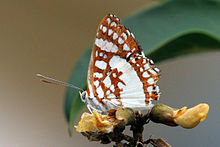
The superfamily Papilionoidea contains all the butterflies except for the moth-like Hedyloidea.

Lycaenidae is the second-largest family of butterflies, with over 6,000 species worldwide, whose members are also called gossamer-winged butterflies. They constitute about 30% of the known butterfly species.

Riodinidae is the family of metalmark butterflies. The common name "metalmarks" refers to the small, metallic-looking spots commonly found on their wings. The 1,532 species are placed in 146 genera. Although mostly Neotropical in distribution, the family is also represented both in the Nearctic, Palearctic, Australasian (Dicallaneura), Afrotropic, and Indomalayan realms.

Apodemia is a New World genus of metalmark butterflies found from Canada to Brazil.

Hamearis lucina, the Duke of Burgundy, the only member of the genus Hamearis, is a European butterfly in the family Riodinidae. For many years, it was known as the "Duke of Burgundy fritillary", because the adult's chequered pattern is strongly reminiscent of "true" fritillaries of the family Nymphalidae.

Miletinae is a subfamily of the family Lycaenidae of butterflies, commonly called harvesters and woolly legs, and virtually unique among butterflies in having predatory larvae. Miletinae are entirely aphytophagous. The ecology of the Miletinae is little understood, but adults and larvae live in association with ants, and most known species feed on Hemiptera, though some, like Liphyra, feed on the ants themselves. The butterflies, ants, and hemipterans, in some cases, seem to have complex symbiotic relationships benefiting all.

Riodininae is the largest of the three subfamilies within the metalmark butterfly family, Riodinidae.
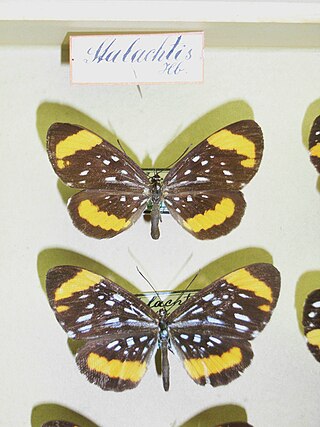
Stalachtis is a genus of metalmark butterflies. It is currently the only member of the tribe Stalachtini, but many metalmark butterflies are yet to be unequivocally assigned to tribes, so this might change eventually.

The Riodinini are one of the large tribes of metalmark butterflies. As numerous Riodinidae genera have not yet been unequivocally assigned to a tribe, the genus list is preliminary.

The Mesosemiini are one of the tribes of metalmark butterflies. They are the basalmost living tribe of the Riodininae, outside the main radiation together with the slightly more advanced Eurybiini.

The Eurybiini are a small tribe of metalmark butterflies. They are one of the basal tribes of the Riodininae, outside the main radiation but not quite as primitive as the Mesosemiini. Though numerous Riodinidae genera have not yet been unequivocally placed in a tribe and the genus list is thus preliminary, it is not very likely that many other genera will end up being assigned here.

The Symmachiini are a tribe of metalmark butterflies.

The Helicopini are a tribe of metalmark butterflies.

Zizeeria knysna, the dark grass blue or African grass blue, is a species of blue butterfly (Lycaenidae) found in Africa, on Cyprus and the Iberian Peninsula.

Emesiini is a tribe of metalmark butterflies in the family Riodinidae. There are at least 2 genera and about 15 described species in Emesiini.
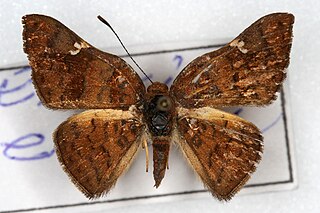
Curvie emesia, the curve-winged metalmark, is a species of metalmark in the butterfly family Riodinidae. It is found in North America.
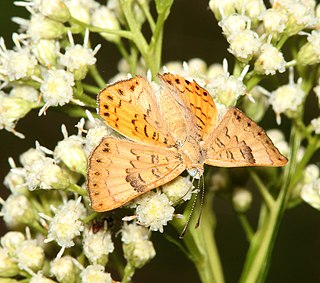
Apodemia zela, the zela metalmark, is a species of metalmark in the butterfly family Riodinidae. It is found in North America.
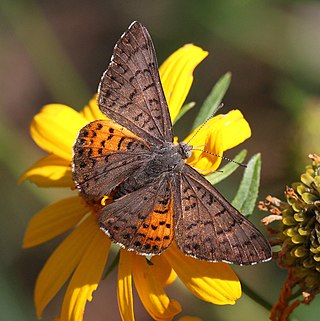
Apodemia ares, the ares metalmark, is a species of metalmark in the butterfly family Riodinidae. It is found in North America.

Nemeobiinae is a subfamily of Riodinidae, the metalmark family. The subfamily's members consist entirely of Old World members of the Riodinid family. Recent revisions to the subfamily have begun to include members located within the New World as well, however, the subfamily continues to encompass the entirety of the Old World Riodinids.

Styx is a monotypic genus of butterflies in the metalmark family Riodinidae. It consists of one species, Styx infernalis, described by Otto Staudinger in 1875. It is endemic to Peru, where it inhabits tropical montane cloud forests between the elevations of 1000-1600 meters.
